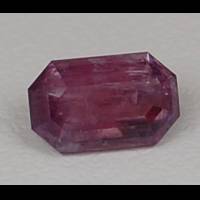Tremolite

Hexagonite
Fowler, St. Lawrence County, New York, USA
2.07 carats
© Rarestone.com
Tremolite occurs as grey, green or lavender to pink stout elongated crystals, which form fibrous, granular or columnar aggregates. They are known as fine needle-like inclusions in quartz or emerald. The needles produce a distinct cat's eye effect in cabochons cut from compact green Tremolite from Ontario, Canada.
Tremolite Gemstones by Colour
This table shows the variety of hues this gemstone can be found in. Click on a photo for more information.
| General Information | ||||||||||||||||||||||
|---|---|---|---|---|---|---|---|---|---|---|---|---|---|---|---|---|---|---|---|---|---|---|
| Varieties/Types: | Chrome-Tremolite - A chromian Tremolite. Hexagonite - A transparent lilac-pink variety of Tremolite. | |||||||||||||||||||||
| Chemical Formula |
| |||||||||||||||||||||
| Physical Properties of Tremolite | ||||||||||||||||||||||
| Mohs Hardness | 5 to 6, Blue Chart Gem Identification (2010) More from other references | |||||||||||||||||||||
| Specific Gravity | 2.95 to 3.07, Gemstones of the world (2001) More from other references | |||||||||||||||||||||
| Cleavage Quality | Distinct, Gemmological Tables (2004) More from other references | |||||||||||||||||||||
| Fracture | Uneven, Gemstones (2009) | |||||||||||||||||||||
| Optical Properties of Tremolite | ||||||||||||||||||||||
| Refractive Index | 1.599 to 1.637, Blue Chart Gem Identification (2010) More from other references | |||||||||||||||||||||
| Optical Character | Biaxial/-, Blue Chart Gem Identification (2010) More from other references | |||||||||||||||||||||
| Birefringence | 0.023 to 0.028, Blue Chart Gem Identification (2010) More from other references | |||||||||||||||||||||
| Pleochroism | Nil, Gemstones (2009) | |||||||||||||||||||||
| Dispersion | Nil, Gemstones (2009) | |||||||||||||||||||||
| Chatoyancy | Yes, Gemmological Tables (2004) | |||||||||||||||||||||
| Colour | ||||||||||||||||||||||
| Colour (General) | Grey-brown, green, colourless, white, pink., Gemstones of the world (2001) More from other references | |||||||||||||||||||||
| Causes of Colour | Pink (hexagonite), Mn3+, Pragmatic Spectroscopy For Gemologists (2011) | |||||||||||||||||||||
| Transparency | Transparent,Translucent, Gemmological Tables (2004) More from other references | |||||||||||||||||||||
| Lustre | Vitreous,Silky, Gemstones of the world (2001) More from other references | |||||||||||||||||||||
| Fluorescence & other light emissions | ||||||||||||||||||||||
| Fluorescence (General) | Occasionally orange, Gemmological Tables (2004) | |||||||||||||||||||||
| Crystallography of Tremolite | ||||||||||||||||||||||
| Crystal System | Monoclinic, Blue Chart Gem Identification (2010) More from other references | |||||||||||||||||||||
| Habit | Fibrous, granular or columnar aggregates, Gems, Sixth Edition (2006) More from other references | |||||||||||||||||||||
| Geological Environment | ||||||||||||||||||||||
| Where found: | Tremolite is formed by contact metamorphism of Ca–Mg siliceous sediments and in metamorphics derived from ultramafic or magnesium carbonate rocks., Gems, Sixth Edition (2006) | |||||||||||||||||||||
| Further Information | ||||||||||||||||||||||
| Mineral information: | Tremolite information at mindat.org | |||||||||||||||||||||
| Significant Gem Localities | ||||||||||||||||||||||
| ||||||||||||||||||||||
